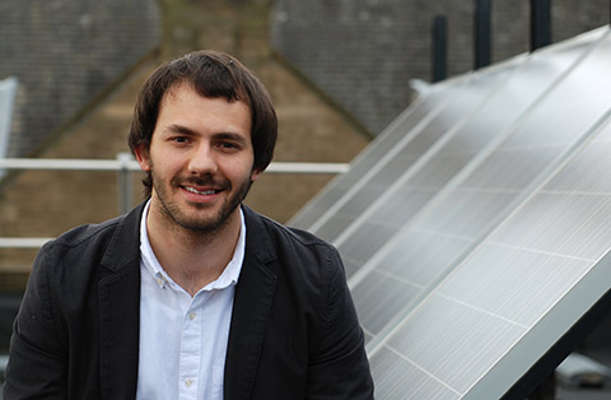In the UK alone, some 1.5 million homes are equipped with solar panels, and it has been estimated that by 2020 the figure could soar to 10 million, with the prospect of lower energy bills for consumers and massive reductions in CO2 emissions.
Now, a University of Huddersfield researcher is developing new technologies that could enable clusters of houses to share their solar energy, rather than simply exporting surplus electricity to the national grid. Also, new systems for fault detection will enable householders to monitor and maintain the efficiency of their panels.
Prize-winning PhD student Mahmoud Dhimish is spearheading the project, supervised by lecturers with expertise in high performance computing, engineering and electrical supply. The research is aided by a solar panel, or photovoltaic (PV) system that has been installed at the University by its School of Computing and Engineering.
“Currently, individual consumers generate electricity from their PV installations and if they are unable to use it, they export it to the network. PV outputs vary unpredictably — as do the electricity demands of each consumer — so supply and demand is difficult to match,” said Mahmoud Dhimish.

Dr Mahmoud Dhimish and his solar panels, weather station on the University’s campus (University of Huddersfield)
A major dimension of Mahmoud’s work is the development of a new algorithm that will enable the rapid detection of faults in PV installations. He has carried out pioneering work on the impact of micro-cracks in the performance of solar panels, using the facilities of the University of Huddersfield’s High Performance Computing Research Group to carry out his analysis.
The research could lead to the development of monitoring units operated directly by households or remotely via the Cloud.
Outputs describing the work have included the recent article Fault detection algorithm for grid-connected photovoltaic plants, in the journal Solar Energy. It is co-authored by Mahmoud Dhimish and his PhD supervisor Dr Violeta Homes, who is Subject Area Leader for Electronic and Electrical Engineering at the University of Huddersfield, where she leads the HPC Research Group.
Also supervising are Dr Bruce Mehrdadi, who is MSc Engineering Programme Leader, and lecturer Mark Dales, whose career has included 30 years in the electricity supply industry, and who took charge of the installation of the School of Computing and Engineering’s own solar panels.
Mahmoud Dhimish — who is Jordanian-Russian — earned awards that included a Chancellor’s Prize for his University of Huddersfield MSc in Electronic and Communication Engineering. He was immediately awarded a scholarship for his PhD research in renewable energy system. He has further co-authored articles awaiting publication and has also lectured on the subject to undergraduates.
Reference(s):
1. Publication: Mahmoud Dhimish, Violeta Holmes, Bruce Mehrdadi, Mark Dales. Diagnostic method for photovoltaic systems based on six layer detection algorithm. Electric Power Systems Research, 2017
2. Research story: University of Huddersfield | June 14, 2017 (source)














Comments